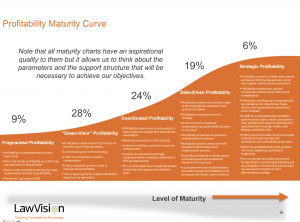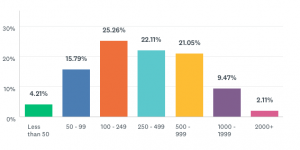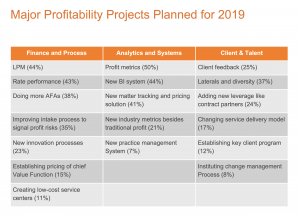Mark Twain is often reputed to have stated that “history doesn’t repeat itself, but it often rhymes.” This phrase comes to mind when reading recent reports from The American Lawyer on the performance of large law firms in 2018. In its reporting, The American Lawyer observed that the Am Law 100 grew revenue at 8% over the year. Perhaps more compelling is the finding that results were more evenly balanced throughout the group than in recent years, which counters the highly dispersed results that have occurred over the past decade since the 2009 recession.[1]
Notwithstanding this good news, and related to Mr. Twain’s statement, 2018 has the feel of pre-recession days with twists of change. We live in a legal world where “data scientist” is the sexiest new title in the firm, where clients are highly sophisticated buyers of legal services, where the march of alternative legal providers is thundering, and the coming age of sophisticated legal technology is at the doorstep.
Some firms are morphing faster than others. For example, Clifford Chance was recently reported to aspire to rid the firm of the “tyranny of the billable hour,”[2] industry consolidation through law firm mergers was the highest (72 mergers) since 2001. And in spite of the recent positive legal economic news, not all firms are faring well in today’s legal economy.
More specific to the financial management of firms, Peer Monitor reported the strongest rate increases in 2019 seen in over a decade with top firms pushing rates towards the 6% growth mark. Against the backdrop of those gains, and based on regular conversations with law firms, all is not perfect. There is much discussion about things like pricing strategy, partner financial performance, cash leakage and overall concern over profitability. There is a strong desire by law firm leaders to introduce into the standard lexicon a greater sophistication on profitability acumen by the partners. And the reality is that profitability is one of the hottest topics being worked today.
Of course, profitability is a broad topic: one that can be addressed by pricing strategies, driving efficiencies, computing profit metrics, growing clients, managing discounts, managing cash, among other topics. The challenge for law firm leaders is that profitability is the net result of many activities of the firm that are required to run well to achieve these satisfactory margins. Knowing the relative value of the dollar is becoming an overarching goal.
Large Law Firm Profitability Survey
To that end, LawVision joined by Iridium Technologies recently conducted a profitability survey among large law firms, and received 99 responses. The results were illuminating and reinforce the feeling held by many that the industry is changing but also still connected its legacy roots. There was a nice range of size and profile of law firms as illustrated by the graph below:
Executive Findings
In the survey we observed the key findings:
- Profitability and profit management are critical topics for firms of varying sizes, all of whom are embracing these subjects in different ways
- A majority of the firms are satisfied with their profitability over the past three years, however, a significant number of respondents (one-third) reported flat or negative growth in profitability
- There are a wide range of projects underway in 2019 designed to address profitability, including creating new metrics, implementing project management, deploying new BI systems, addressing rate performance, exploring alternative pricing methods, and implementing matter tracking, among others
- Most firms are in the early to mid-maturity levels of integrating profitability into the normal flow of firm operations as measured against the LawVision profitability maturity curve
- Common barriers such as partner resistance and organizational inertia are blockers towards embracing a performance culture
- Few firms are integrating profitability into the compensation system
- Stand-alone tools such as Excel spreadsheets remain common in the analysis of profitability, but firms are rapidly embracing other systems to do this task
- Reporting transparency to partners remains mixed and limited, and are often subject to matters, clients, and partner performance
- Automation in the reporting process and on-demand access to this data is mixed
- There are a wide range of policies surrounding various “nut and bolt” items such as determining allocation methods, handling time shifts, appropriating business development expenses for partners, smoothing cost concerns, and other issues including profit calculation reconciliation to the firm’s general ledger income statement
Law Firm Profitability Maturity

One of the interesting questions that arises when assessing firm profitability is the progression along the maturity curve to profitability. LawVision’s profit maturity curve invites firms to consider the fundamental and broad-based elements of profitability to not only understand where they are today but where they compare to other firms and industry standards, and the broader elements of profitability including analytical and client-centered dimensions.
The maturity curve depicted below illustrates where firms self-reported on our maturity curve evolving from early-stage piece-meal profit actions to a fully integrated approach.
Major Projects on Profitability
The survey revealed a variety of 2019 projects planned for 2019 that we grouped into three major categories: finance/process, analytics, and client-centric. While many firms have been developing profit models and introducing them into operations of the firm, we are observing that many new profit projects have a strong connection to more modern focus areas like analytics, client service, the attraction of talent, among other important profitability topics.
Summary
In summary, the survey revealed that the industry may be rhyming with the past but that achieving profitability very much has to do with adopting modern practices. The pace of change anticipated in the coming 5 to 10 years is expected to challenge law firms to take on even more dramatic change in their thinking around profitability and client service. Resulting profitability will have a strong connection to those steps taken.
[1] Packel, Dan, “The Am Law 100 Reached New Heights, Driven by Nearly Universal Growth,” The American Lawyer, April 23, 2019.
[2] Rubino, Kathryn, “Biglaw Firm Unveils Plan to Do Away with Billable Hours as a Metric to Evaluate Associate Performance,” The American Lawyer, May 3, 2019.




